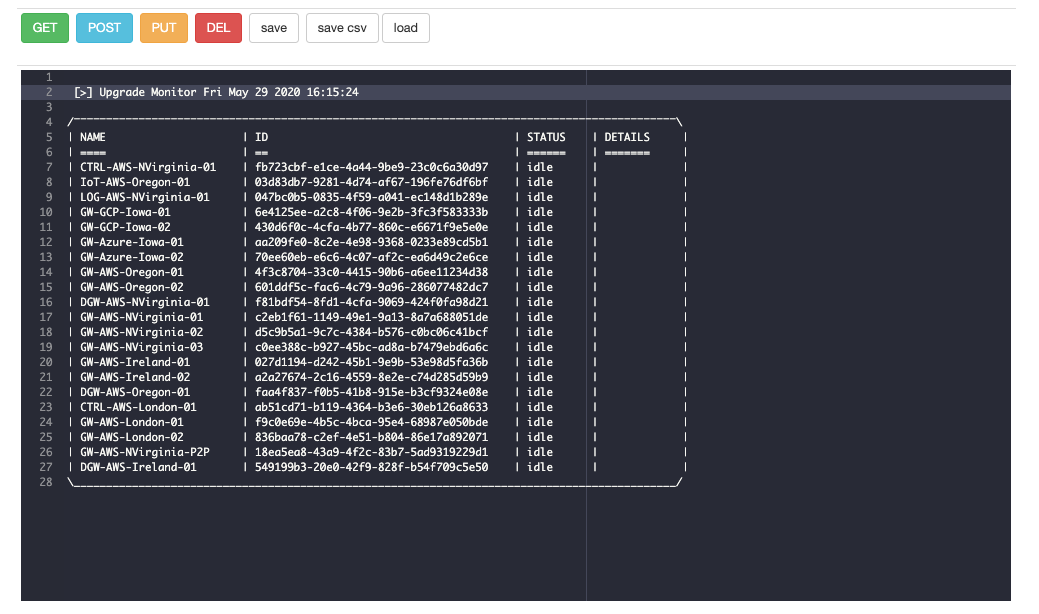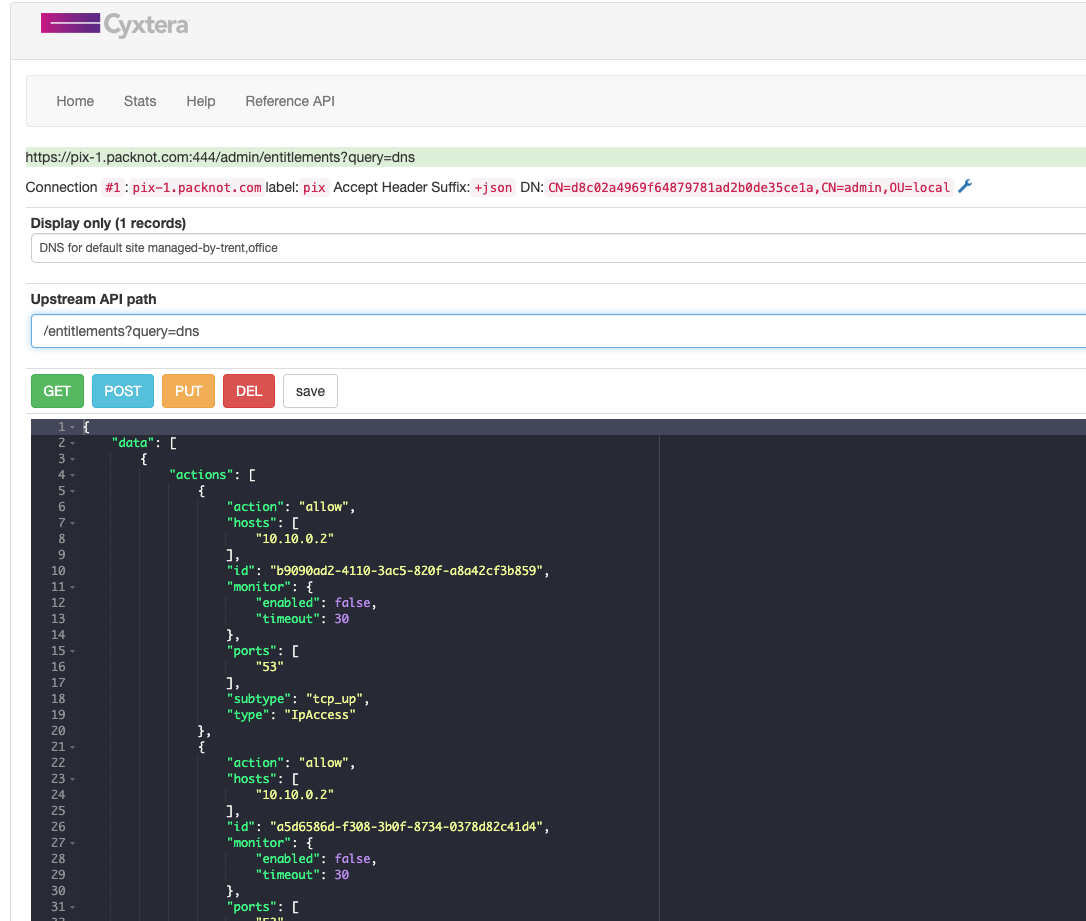Examples
Conkolla has a API spec on board and parses it for quick access: If you open the help page in the Conkolla UI, it will generate for every connection you have a list of clickable API examples, primitively generated from the on-board spec (which might be out-dated, but good as basic examples). The on board API spec does also feed the autocomplete for the editor entity entry field; check apispec to display the file and version.
- The link to the Reference API in the top menu will always point to the latest version.
- Some examples use the developer mode of your browser, more instruction can be found here.
Start the upgrade monitor
The monitor updates every 10 seconds and can be useful to monitor an upgrade. To start it do:
- Open the editor of the connection
- Open the developer tools of chrome, then in the console type:
startUpgradeMonitor(). - Close the developer tools.
The monitor ends if you reload (or move away) the page.

Login through curl (command line)
curl -s -H "Accept: application/json" -X POST \
-kL https://localhost:4433/login \
--data '{"username":"admin", "password":"secret sauce","ControllerURL":"cc1.packnot.com", "apiVersion":9, "skipVerifySSL":"true","label":"dev"}'
Response example:
{
"EntitlementTokenExpires": "2019-04-10T10:24:31.246Z",
"authBody": {
"machineId": "0e9076cd-e09e-4db7-6d24-480196700a42",
"providerName": "local",
"username": "admin",
"password": ""
},
"connectionID": "1",
"loginParameters": {
"ControllerURL": "cc1.packnot.com",
"ControllerPort": 444,
"username": "admin",
"password": "removed",
"otp": "",
"providerName": "local",
"apiVersion": 9,
"acceptHeaderSuffix": "+json",
"contentTypeHeader": "application/json",
"label": "dev",
"machineId": "0e9076cd-e09e-4db7-6d24-480196700a42",
"hideToken": "",
"skipVerifySSL": "true",
"dumpAGResponse": "",
"autoTokenRenewal": ""
},
"message": "Successfully connected."
Example query in the Conkolla UI
Use the following query parameters to search for entities: query. Example /entitlements?query=dns.

Browser developer tools: wrappers for multi entity manipulation
With the developer tools (use crhome, at least ECMAScript2018) you can easily do multi entity manipulation from/to/on same/other connected controller. See the reference documentation for developer mode.

Example: Add a rsyslog destination to all appliances in the collective
- Select the records you need to work on (here all appliances): GET
/appliances. Result is displayed in editor and available as an array of records (appliances) in the variabledataRecords. - Open devleoper tools > console
- Write the code to update the value
- Run the code in the console.
You can use the built in putEntity(conID, entity, record) function to update existing appliances entities:
newRsyslogDest = { // the new syslog config to be added
"destination": "@@loc.logs.packnot.com:5555",
"selector": "# certificate files - just CA for a client\n$DefaultNetstreamDriverCAFile /etc/ssl/certs/rsyslog.pem\n \n# set up the action\n$DefaultNetstreamDriver gtls # use gtls netstream driver\n$ActionSendStreamDriverMode 1 \n$ActionSendStreamDriverAuthMode anon # server is NOT authenticated\n:msg, contains, \"[AUDIT]\"",
"template": "%msg:9:$%\\n"
};
// append config to rsyslog destinations
for (let record of dataRecords){ // dataRecords contains the result of the last GET request from UI
var entity = "appliances"; // the entities we operate on
var conID = 1; // the controller conection
var dests = record["rsyslogDestinations"];
dests.push(newRsyslogDest);
record["rsyslogDestinations"] = dests;
//update the entitiy
let result = putEntity(conID, entity, record)
console.log(JSON.stringify(result, null, 4)))
}
Examples of manipulating entities
Update notes field on all entitlements, using UI and JS console.
1. load all the entities into the editor: _GET_ /entitlements.
The results is stored in dataRecords
2. Write the modify function:
function update(record){
record["notes"] += "another confusing note!";
return record;
}
3. Write the update code
for (let record of dataRecords){
putEntity(1, "entitlements", update(record));
}
3.1 An alternativ update code: Use getAndUpdatEntity function
You would use this function when the ID is referenced from another entity type, for example from a policy. It is shown as an example here
for (let record of dataRecords){
getAndUpdateEntity(1,"entitlements",record["id"], update);
}
3.2 Change by hand: when you manually changed data in your window
The dataRecords is only updated when you use the UI for the request. Now, if you by hand changed data in the editor, the new values will not update the content of dataRecords – it will always contain the original.
If you want to use the current data from the editor, then use entitiesFromEditor:
entitiesFromEditor(1, "entitlements", putEntity)
Update notes field on all entitlements, using only console
Note you need to be on the editor page for the necessary JS code (used function etc) to be loaded loaded.
This code goes as to the above steps, with the difference of doing all the steps programmatically. Here the code:
function update(record){
record["notes"] += "another confusing note!";
return record;
}
// now this is the major difference: block until the promise is resolved.
var result = await getEntity(1,"entitlements");
for (let record of result.data){
putEntity(1, "entitlements", update(record));
}
Update global settings on many controllers
function updateGlobalSettings(gs){
gs["claimsTokenExpiration"] = 720;
return gs
}
for (var i=1; i< 21; i++) {
getAndUpdateEntity(i,"global-settings", "", updateGlobalSettings);
}
Copy entities from one system to another
This example demonstrates how you can copy entities from one to another system in a controlled and assisted way. The below example copies entitlements by using the in-editor loaded entitlements:
- Log-in to both controllers
srcanddst, assure you have the privileges to write entitlements on dst. - Open the Chrome Developer console, then open the editor with
/entitlementsfor the source system. - Look through the entitlements, check if any adjustments will be needed:
- Mapping attribute values from src to dst (e.g site id, conditions etc)
- Dropping/adding any attributes if src and dst do not have same entity scheme due to different Appgate versions; however you should always run src and dst on same version, but sometimes this is not an option.
Either you do changes directly in the editor window by hand, or do it programmatically (as in the below example). If you do all changes in the window, remember to use entitiesFromEditor instead of postEntity.
var destination = 2 // connection ID for the destination
site_mappings = {"8a4add9e-0e99-4bb1-949c-c9faf9a49ad4":"8a4add9e-0e99-4bb1-949c-c9faf9a49ad4"}
for (let record of dataRecords){
// adjust site mapping
record["site"] = site_mappings[record["site"]]
// add tag
record["tags"].push("imported")
// remove any admin roles
delete record["administrativeRoleLinks"]
delete record["administrativeRoles"]
// note you could instead create a new entitlement with the minimal required fields,
// and add any fields on the fly.
// Add new entity. Use await to let the promise be resolve (throttles the nr of requests).
await putEntity(destination, "entitlements", record)
}
Alternatively use pure javascript, e.g not using the entitlements loaded into the editor:
var src = X // where X is the nr or name of the connection with the source
var dst = Y // where Y is the nr or name of the connection with the destination
getEntity(src, "entitlements")
for (let record of consoleDataRecords) {
// 1. change/create new entity
// 2. put entity
}
Update NTP servers on all appliances in a cluster for many clusters
This is an example drawn from our training environment where we have multiple clusters, where one cluster is given per training attendee:
cons = [1,2,3,4,5,6,7,8,8,10,11,12,13]
servers = [{"hostname": "0.ubuntu.pool.ntp.org"},{"hostname": "1.ubuntu.pool.ntp.org"},{"hostname": "2.ubuntu.pool.ntp.org"},{"hostname": "3.ubuntu.pool.ntp.org"}]
function update(r){
r["ntp"]["servers"] = servers
return r
}
for (let con of cons){
console.log(con)
var result = await getEntity(con, "appliances")
for (let record of result.data){
putEntity(con, "appliances", update(record))
}
}
Clean-up user records
When a user is terminated (the identity shall be removed from the IdP), clean-up scripts will usually take care of removing all the parts and pieces for that user. Admins can hook in and use for example power-shell scripts. In one of the clean-up stages you would have then a script which does the clean-up in Appgate for that user:
- free the license
- delete all on boarded devices
- remove otp seeds
Sometimes you need to run a one-off to clean out a user in Appgate. This code will do it:
// config
let username = "Raymond.Reddington" // the user for which the clean-up is done
let conId = 1
entitiesKey = [ { "key": "userDistinguishedName", "path": "license/users"},
{ "key": "distinguishedName", "path": "on-boarded-devices"},
{ "key": "userDistinguishedName", "path": "otp/seeds"}]
// setup
var reExactly = new RegExp("^" + username + "$");
let candidates = []
// get the possible entities
const workEntities = async (entity) =>{
console.log("get entities: " + entity.path)
let result = await Promise.all([getEntity(conId, entity.path + "?query=" + username)])
// filter for exact match
for (let rec of result[0].data){
console.log(rec)
if (rec.username && rec.username.match(reExactly)){
candidates.push({"key": rec[entity.key], "path": entity.path})
}
}
}
// get and work out the entities to be deleted
await Promise.all(entitiesKey.map(workEntities))
// just review if needed on console log
function printCandidates(){
console.log("Candidates in list:")
candidates.map( (candidate) => console.log(candidate))
}
// deletes the entity stored in candidates
function cleanup(candidate){
console.log("delete: " + candidate.path + "::" + candidate.key)
deleteEntity(conId, candidate.path, candidate.key)
}
// do delete
printCandidates()
candidates.map(cleanup)
Administration Examples
Upgrade an appliance (using the Conkolla UI)
The following example depicts how you can upgrade an appliance from the conkolla UI.
- First find the ID of the appliance you want to upgrade: GET
/appliances - Get the download link for the update zip file. Make sure the appliance can download it.
- Init the upgrade:
POST /appliances/<appliance-ID>/upgrade
{
"imageUrl": "https://user:pass@sdpdownloads.cyxtera.com/Appgate-SDP-4.2/bin/Appgate-SDP-4.2.3.img.zip"
}
Response should be: “202 ACCEPTED”
Status can only be checked by pulling: GET /<appliance-ID>/upgrade. Note that there can be error messages during different states of the upgraded such as
database connection or time-outs during service restarts etc. All these are currently natural for an upgrade.
Check the status of the appliance to verify if all went as should.
Create Backup and Download Backup File (command line)
Note: you can do basically follow the steps and do them in Conkolla UI, which is simpler.
- Get the appliance ID.
- Initiate an appliance backup.
- Poll status of backup.
-
Download the backup.
- Get the appliance ID of the controller:
curl -k -H "Accept: application/json" https://localhost:4433/get/6/appliances
:
"controller": {
"database": {
"location": "internal"
},
"enabled": true
},
:
"id": "f7ab1be3-8d32-4027-bcf3-91da6f0c0560",
- Initiate an appliance backup using the appliance ID
curl -k -H "Accept: application/json" -X POST --data \ '{"objectData":"{\"logs\": true,\"audit\": true,\"opt\": true}",\ "restCall":"/appliances/f7ab1be3-8d32-4027-bcf3-91da6f0c0560/backup"}' \ "https://localhost:4433/post/6/appliances"objectData: the body content. Note this must be a inner JSON string, hence it is between quotes. restCall: the upstream restcall. Translate to Conkolla as:
[AGC] [pix-1.packnot.com] [dev] 2019/05/21 11:21:34 Upstream rest call: /appliances/f7ab1be3-8d32-4027-bcf3-91da6f0c0560/backup
[AGC] [pix-1.packnot.com] [dev] 2019/05/21 11:21:34 Upstream body: {"logs": true,"audit": true,"opt": true}
Response:
{
"id": "dbb45e6c-22fb-11e9-ab06-065aaf365c98"
}
- Check the status of the backup
curl -k -H "Accept: application/json" \ https://localhost:4433/get/6/appliances/f7ab1be3-8d32-4027-bcf3-91da6f0c0560/backup/dbb45e6c-22fb-11e9-ab06-065aaf365c98/status
Example:
{
"status": "done"
}
4 Fetch the backup file
curl -o backup.gpg -H "Accept: application/json" -k https://localhost:4433/get/1/appliances/f7ab1be3-8d32-4027-bcf3-91da6f0c0560/backup/dbb45e6c-22fb-11e9-ab06-065aaf365c98
Note: the AcceptHeader suffix does automatically change from the suffix +json to +gpg. If you implement your own handler, you will need to take this into account.
-rw-r--r-- 1 ron staff 118M 21 Mai 11:50 backup.gpg